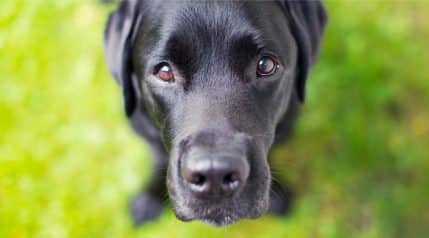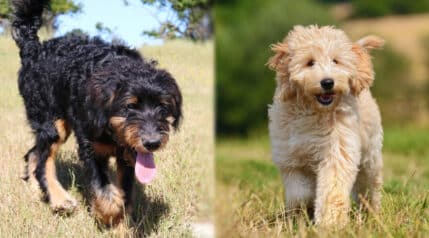Choosing a puppy is hard. Choosing between a Bernedoodle or a Sheepadoodle is even more challenging. Both of these popular doodle dogs can be wonderful and loyal canine companions for singles or large families. These hybrid breeds can bring fun, entertainment, and laughter to any household.
However, it can be difficult for some current or future dog owners to figure out which breed is the best to bring home. After all, they both have many similarities. Will a Sheepadoodle be too much energy to keep up with? Will a Bernedoodle be too laidback for active kids? Does either of them shed a lot, and how much do they cost?
In this article, puppy shoppers can learn the answers to all of these questions and discover the differences between these popular designer dogs. The goal is to help future owners make the wisest decision for their specific lifestyle. Both the dog and owner should be happy!
Breed Comparison
Bernedoodle
- Height 12-29 inches
- Weight 10-90 pounds
- Temperament Friendly, Affectionate, and Playful
- Energy Average
- Health Above Average
- Lifespan 12-18 years
- Puppy Costs $2,000 and Up
Sheepadoodle
- Health 13-37
- Weight 30-80
- Temperament Gentle, Lovable, Lively
- Energy High
- Health Average
- Lifespan 12-15 years
- Puppy Costs $1,000 and Up
Breed History
A breed’s history can speak volumes about its character, size, health, exercise requirements, and much more. Taking the time to understand where each dog comes from can help dog owners picture them as a family pet.
Both dogs haven’t been around for very long. So, how did these beautiful creatures start out? Where do they hail from? Continue reading to discover the origins of these two lovable canines.
Both doodle dogs share purbred poodle parent genes. The Poodle originated in France and Germany, often serving as hunting dogs, water retrievers, and loyal companions. Poodles have low-shedding, curly hair and can also be three different sizes (standard, mini, and micro). Usually, most Bernedoodles and Sheepadoodles have standard-sized parents due to breeding limitations.
Bernedoodle

The Bernedoodle is a combination of a Poodle and a Bernese Mountain Dog. Sherry Rupke of Swissridge Kennels in Canada claims to be the first breeder; however, there may have been crossbreeding instances in the past.
Breeders intended for this designer breed to pair the powerful, hard-working, and affectionate characteristics of the Bernese Mountain Dog with the intelligence, energy, and low-shedding coat of a Poodle.
The Bernese Mountain Dog originally lived in Switzerland’s cold regions and worked on ranches and farms, pulling heavy carts, guarding homes against predators, and driving cattle. Their incredible strength and muscular build made them a highly-favored farm dog.
Sheepadoodle

The Sheepadoodle, also known as “Sheep-a-poo,” is a cross between a Poodle and an Old English Sheepdog. The breed is believed to have existed naturally but began to become well-known in the 1980s due to its hypoallergenic hair.
Breeders wanted to create a large, low-shed dog who was not only affectionate and sweet but also highly active, protective, and family-friendly.
The Old English Sheepdog (also known as a “Bobtail”) is a large, shaggy-haired dog that originated in Western England. The dog was also made famous by the popular Disney movie, “The Shaggy Dog.” These fuzzy pups were bred mainly to herd animals such as sheep or cattle or serve as a watchdog. They are known for their loud, ringing bark (perfect for scaring off trespassers).
Appearance

Both dogs are fluffy and unbelievably adorable. They look alike in many ways, but there are still a few distinctions.
The gentle Bernedoodle appears sturdy and robust, weighing 60-90 pounds and standing 24-29 inches tall. Most of these dogs have a tri-color coat that can come in various combinations of black, white, and brown (in rare cases, gray or dark red). The majority have thick, long, wavy, or curly coats; however, some can have straight hair. They look like and are often mistaken for Aussiedoodles.
On the other hand, Sheepadoodles tend to be slightly larger, weighing between 50-80 pounds and standing between 20-27 inches tall. Like the Bernedoodle, their particular size depends on their Poodle parent’s size.
One of the main differences in appearance is that a Sheepadoodle usually has two coat colors of black, white, or red instead of the Bernedoodles three colors. Sheepadoodles also tend to have curly, soft hair, with either a square sheepdog face or a dome-shaped Poodle head.
Temperament

It’s easy to fall in love with both of these charming breeds, as they can offer endless entertainment, love, and loyalty. Regardless, every crossbred pup is different based on the specific traits they inherit from their parents. Keep in mind that temperaments can vary between dogs.
Bernedoodles tend to be gentle and calm with moderate energy levels, similar to their Bernese Mountain Dog mom or dad. They love to be around people and will try to be everyone’s friend. However, they can be sensitive and frighten easily.
Sheepadoodles are usually more lively and playful. They are brilliant and can naturally pick up on human emotions, making them perfect therapy or emotional support animals. They also make excellent guard dogs, as they are known to alert owners with a loud, resounding bark if there is an intruder present.
Sheepadoodles are instinctive herders, thanks to their Old English Sheepdog genes. Owners may frequently see them trying to herd other animals or children. This behavior is usually accompanied by nipping, but it shouldn’t become a recurring issue with routine, affectionate training.
Exercise

Sheepadoodles inherit higher energy levels from the Sheepdog and are much more willing to engage in intense physical activity than the laid-back, cuddly Bernedoodles. Owners can expect to take them out for more walks and give them the time and space to let off steam. Usually, around 90 minutes or more will suffice. If they don’t get enough exercise, they may start to get a little rowdy and loud.
Sheepadoodles will be happiest in larger homes with fenced-in yards, where they can roam and play freely. Their thick coats also help them withstand colder climates, making them a great buddy for a chilly morning jog or hike.
While Bernedoodles can still keep up (with a little encouragement and maybe a treat), they are more than happy to snuggle up on the couch and take a nap with their owner. They also tend to gain weight quickly, so they need to maintain a routine exercise schedule of at least 60 minutes per day.
Training

Each breed is inherently intelligent, hard-working, and obedient, which makes them easy to train. As with all puppies, it’s essential to introduce new people, sounds, places, and sights early. Mental and physical stimulation is valuable not only in the puppy stage but throughout adulthood.
Sheepadoodles can be boisterous as puppies, but they can learn extremely fast with consistent training and patience. And once a Sheepadoodle learns something, they won’t forget it. This breed can quickly get bored with the same trick or task, so be sure to liven things up with new challenges.
Bernedoodles have a strong desire to please their owners and appreciate affectionate, reward-based training methods. It’s essential to interact regularly with them, as they can become unruly and destructive if left alone for long periods.
It’s wise to remember that a puppy’s attention span is extremely short during the initial training stages. Both dogs need a substantial amount of praise and quick discipline to encourage good behavior. Both dogs become attached to their families and develop separation anxiety, so make sure to address this early on in training.
Health

Although many cross-breeds don’t usually experience the same health conditions as their parents, it’s still important to know the potential risks before buying either dog as a puppy.
Sheepadoodles are relatively healthy, often living anywhere between 12 to 15 years on average. However, they are still predisposed to various dangerous diseases their Old English Sheepdog and Poodle parents face. Some of the most common inherited conditions from the Old English Sheepdog include deafness, cataracts, progressive retinal atrophy, gastric torsion, retinal detachment, among others.
On average, Bernedoodles tend to live longer, healthier lives ranging from age 12 to 18. Although they usually maintain good physical condition, they can still develop the diseases that infect Bernese Mountain Dogs, including hip and elbow dysplasia, eye problems, cardiac issues, and Von Willebrand’s Disease.
These dogs are both at risk for the same conditions of their Poodle ancestry. These can include Cushing’s disease, various ocular diseases like progressive retinal atrophy, thyroid issues, and different skin conditions such as sebaceous adenitis.
Dog owners should focus on proper nutrition, regular exercise, and schedule regular appointments with a veterinarian. Doing so will ensure their pup is as healthy and happy as possible.
Nutrition

All puppies require high-quality meals with the appropriate amount of protein, vegetables, and fats they need to grow into healthy adult dogs. Most veterinarians suggest feeding dogs twice per day. The amount of food depends on the dog’s size, age, breed, and energy level.
Generally speaking, both of these dogs will be large dogs. Because both breeds are larger dogs, both will need a kibble designed for a large breed. These commercially produced dry kibbles are usually the best source for either dog to get the nutrients they need.
Expect both dogs to eat anywhere from 3 to 5 cups of dry dog food per day as adults, depending on their size. While this is the average, it’s not uncommon for larger males to get closer to 6 cups of dry dog food per day.
When picking out the right kibble, you need to make sure you start with an age-appropriate formula. Start with a Large Breed Puppy formula, and then move onto a dog food formula for large breed adults. Seniors will have a little more flexibility depending on your dog’s size or weight.
Don’t be swayed by those heart-melting puppy eyes during mealtime. Overeating can cause obesity and other health problems. Focus on providing consistent, proper portions of food rich in nutrients.
Grooming

Neither of these dogs are aggressive shedders thanks to their Poodle genes, which is part of why they have become so popular in recent years. They are also mostly hypoallergenic, making them an excellent pet for those who suffer from chronic allergies.
However, both require regular grooming that can be somewhat challenging, depending on their hair’s texture, thickness, and length. It’s best practice to brush them at least two to three times per week and receive a haircut (especially around the eyes) every 8-12 weeks.
Mats, knots, and tangles are painful for the dog, so be sure to make routine, at-home brush (and bonding) appointments with your fluff ball. Investing in the right tools can help make things run smoother. Pin brushes, combs, slicker brushes, and dematting brushes are all great tools to keep on hand.
Owners should have a proper maintenance plan in place for their precious pups. This should include monthly baths (depending on how much they play in the dirt or mud!), regular nail clippings, and teeth brushings (or dental stick chews).
Price

Both breeds have gained popularity in the U.S. over the years. The cost of both dogs is about the same, with the Bernedoodle price ringing in a little higher due to its rarity, high demand, and low breeding success rate. They also offer a wider selection of coat colors (tri-color instead of bi-color)
Remember that size, age, and color each play an integral role in the pup’s price. Adoption or purchase through a breeder can also significantly impact the cost. For a quality bred Bernedoodle puppy, expect to pay upwards of $2,000. For a well-bred Sheepadoodle, it can be a little cheaper at approximately $1,000 and up.
Find a reputable breeder if you’re looking to purchase a puppy. Look for someone who can readily provide health documentation, is open for visitors, and takes the time to answer all questions.
Final Thoughts
Countless dog owners everywhere have welcomed both of these designer dogs into their homes and lives. Don’t be intimidated by their large size! These fluff balls’ charming personalities, intelligence, and fun-loving attitudes make them perfect pets, especially for families with children.
Those with more active lifestyles and larger homes may benefit from having a larger, more energetic Sheepadoodle who’s always ready for the next adventure. In comparison, owners with a more relaxed way of life may appreciate the more peaceful, happy-go-lucky Bernedoodle who would prefer an afternoon snuggle session. Either way, these adorable pups will warm your heart and be a devoted, life-long companion!






Thankyou so much for the above information. I am wanting either of the pups but am finding it difficult in the UK. Many thanks